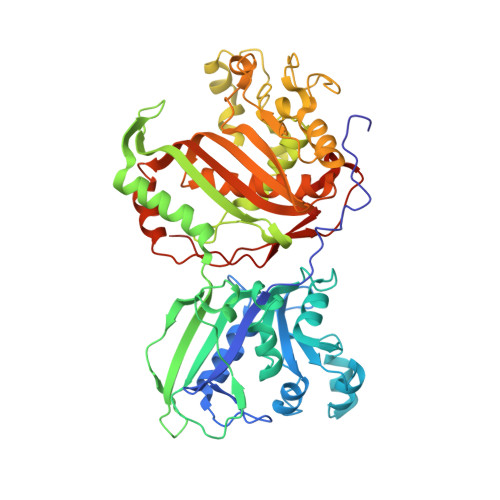Structure-based approach to pharmacophore identification, in silico screening, and three-dimensional quantitative structure-activity relationship studies for inhibitors of Trypanosoma cruzi dihydrofolate reductase function.
Schormann, N., Senkovich, O., Walker, K., Wright, D.L., Anderson, A.C., Rosowsky, A., Ananthan, S., Shinkre, B., Velu, S., Chattopadhyay, D.(2008) Proteins 73: 889-901
- PubMed: 18536013
- DOI: https://doi.org/10.1002/prot.22115
- Primary Citation of Related Structures:
2H2Q, 3CL9, 3CLB - PubMed Abstract:
We have employed a structure-based three-dimensional quantitative structure-activity relationship (3D-QSAR) approach to predict the biochemical activity for inhibitors of T. cruzi dihydrofolate reductase-thymidylate synthase (DHFR-TS). Crystal structures of complexes of the enzyme with eight different inhibitors of the DHFR activity together with the structure in the substrate-free state (DHFR domain) were used to validate and refine docking poses of ligands that constitute likely active conformations. Structural information from these complexes formed the basis for the structure-based alignment used as input for the QSAR study. Contrary to indirect ligand-based approaches the strategy described here employs a direct receptor-based approach. The goal is to generate a library of selective lead inhibitors for further development as antiparasitic agents. 3D-QSAR models were obtained for T. cruzi DHFR-TS (30 inhibitors in learning set) and human DHFR (36 inhibitors in learning set) that show a very good agreement between experimental and predicted enzyme inhibition data. For crossvalidation of the QSAR model(s), we have used the 10% leave-one-out method. The derived 3D-QSAR models were tested against a few selected compounds (a small test set of six inhibitors for each enzyme) with known activity, which were not part of the learning set, and the quality of prediction of the initial 3D-QSAR models demonstrated that such studies are feasible. Further refinement of the models through integration of additional activity data and optimization of reliable docking poses is expected to lead to an improved predictive ability.
- Department of Pharmaceutical Sciences, University of Alabama at Birmingham, Birmingham, Alabama 35294, USA.
Organizational Affiliation:


















